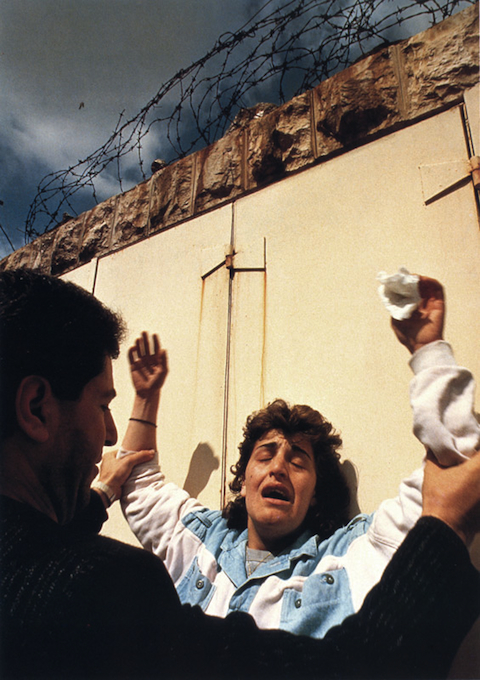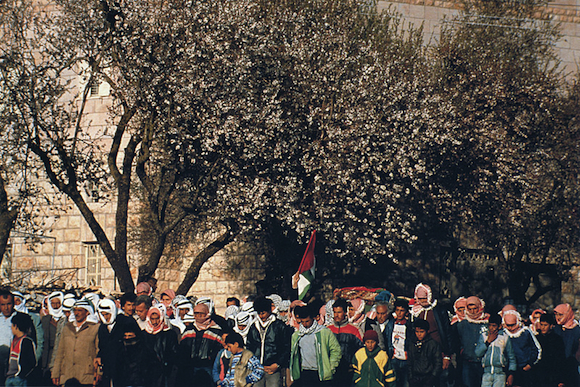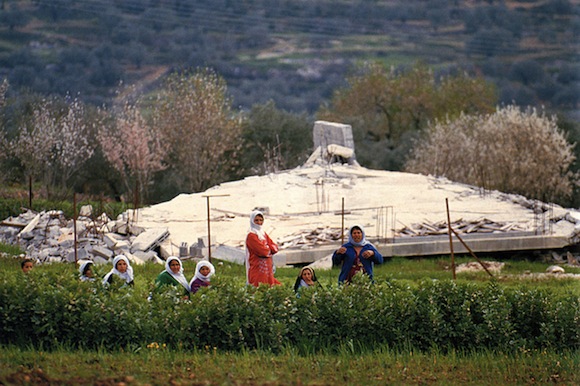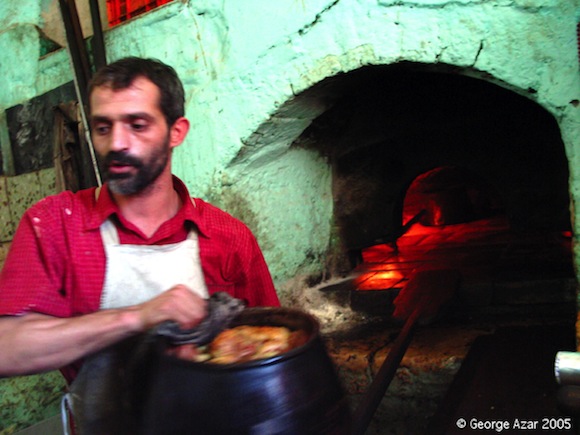George Azar is a Lebanese-American photographer and filmmaker who has been documenting life in the Levant since 1981. At that time he left California to photograph the Lebanese civil war with an eye to the complexity of the human experience of those events. When the first intifada began in 1987, Azar documented life in the West Bank with the same fine-grained approach. During the second intifada, Azar’s This is Palestine project moved in a different direction by focusing on what, as Darwish says, makes Palestinian life worth living.
In this collection, the second in a series of Palestinian youth commentary on photography, Palestinians who grew up in Bethlehem during the second intifada look at Azar’s photographs of their city from the first intifada and in more recent years. Comparing the first intifada with contemporary days, they recognize similar hopes and fears. They also detect changes. Azar’s work makes us wonder: What is the different resonance of a homemade flag as opposed to one produced in a factory, far away? We read here about a famous Bethlehem oven that demonstrates the creativity and work that goes into maintaining Palestinian tradition. These writings also embrace the ambiguity of images that capture Israeli violence and Palestinian steadfastness in one gesture. Together they highlight how Palestinians have refashioned their identities in the face of political trauma while maintaining a commitment to collective survival.
- Amahl Bishara
For more about the photography project, “With Our Ideas, We Take Our Portrait,” read Amahl Bishara`s essay "Permission to Caption."
 [
[
[Reviving a woman stricken by tear gas. Photo by George Azar.]
Abdel Fattah Daajneh, 19
The way the man grasps the woman’s arms in this photograph suggests two possibilities: Is he helping a woman who has inhaled tear gas while participating in a demonstration against Israeli occupation? Or is he a jailer who is torturing and interrogating his prisoner?
In the last days of 1987, the first Palestinian intifada began, and the Palestinian woman silenced every voice that doubted her commitment to the struggle to defend her land. We see evidence of her commitment here. We also see from this image the pervasive violation of the land. Gates are closed. Even homes are encircled by wires and fences.
 [Khadr’s funeral procession winds through his village. Photo by George Azar.]
[Khadr’s funeral procession winds through his village. Photo by George Azar.]
Amani Adais, 17
We have grown accustomed to hearing of martyrs’ funerals. The colors of the kufiyyah and the flag unite Palestinians on these occasions. They have become icons for those seeking justice. Yet, the flag in this picture is even dearer than the flags of today, because during the first intifada, the Palestinian flag was prohibited, and people had to make it by hand. The mourners stand under a great blooming tree that reminds us that even when a branch is cut, the tree’s roots give it the strength to regrow new branches. This symbolizes the perseverance of the Palestinian people.

[Protest. Photo by George Azar.]
Miras al-Azza, 20
"No voice can be raised above the voice of the uprising," said the martyr Khalil al-Wazeer, or Abu Jihad. This picture embodies the real meaning of the "intifada of stones," in which all parts of society worked together to complete each other. Many said of this time that there was no difference between rich and poor, or men and women. This is what distinguished the first intifada, and this is something we lost during the al-Aqsa intifada. Our unity helped our voices reach the world with a strong message against Israeli racism. It was an uprising of the stone against the bullet. I don’t mean to say that the outcome of the second intifada was weak, but if all parts of society had been involved, our results would have been better.

[A home bulldozed by the Israeli army in the village of Beita. Photo by George Azar.]
Areej Asad, 16
Our Condition In Springtime
When I first glance at this photograph, I take in the beauty of the Palestinian landscape. Everything in this photograph speaks of spring: Palestinian women farmers harvesting greens, olive trees with their white blossoms. Even the colors of the women’s embroidered dresses seem here to express joy at the coming of spring. Then there are elements that almost blend into the nature, but in fact are not natural at all. A demolished house lays flat behind the women. A fence separates the women from this house.
As a Palestinian woman, when I see these things, the first thing that comes to my mind is the savagery of the occupation that has caused the destruction of the house and pushed these women from it. We can assume that these women are sad about their demolished house and what they must have witnessed at the hands of the occupying army. But also, we might guess that they are not comfortable with the photographer taking their picture. It may be difficult for us – especially those who are not Palestinians – to understand the reactions of the women. Is this a look of anger from the women because of the demolished house? Or could they be shouting at the photographer not to take their pictures? Or perhaps they are allowing the photographer to take their picture – despite their discomfort – because of the destroyed house.

[Wood oven in Bethlehem. Photo by George Azar.]
Mohammad al-Azza, 23
The Wood Oven is Part of a Living Palestinian Heritage
This photograph, taken in 2005, depicts an oven well known to everyone in Bethlehem and surrounding villages. In the old days, this oven baked only bread, but today it is used to bake the most delicious dishes of the people’s hearty cuisine. It was established in Ottoman times, and passed down until it reached the hands of Hajj Khaled and his brother Fadi Obeidallah, who inherited this oven from his father and his grandfather before him. The Obeidallah family comes from the village of al-Qabu, which was located southwest of Jerusalem and which was destroyed in 1948. The family moved to Bethlehem when they became refugees. It was in the aftermath of this catastrophe that they acquired the oven.
Especially in those days, cooking was a woman’s domain. But Hajj Khaled’s father was fond of cooking, and he refused to concede it entirely to women. He insisted on helping his wife make the meals, until he decided to turn the family oven into a bread oven for the community and finally into an oven for making traditional meals.
In this picture, Hajj Khaled is making qidra. Qidra consists of rice and lamb. It must be cooked in sheep’s butter rather than oil, and one mustn’t forget the garlic. It should be cooked in a copper pot (the qidr) on a wood fire. It is known to be one of the most famous and oldest of Palestinian dishes, one served in large gatherings like weddings and funerals.
This picture is more than just beautiful – it brings us the fragrant history that permeates this oven. Here, Hajj Khaled is taking the qidra out of the oven in a single strong motion. How many men have stood in this place, and how many hands have carried the long, heavy piece of oak wood, or zana, that the baker uses to maneuver the meals? His experience tells him which dishes to place deep into the oven, and which to place closer to the door. His experience tells him how long he can leave the zana in the oven without it burning. Being able to regulate the power of the fire and of the flame is also part of the baker’s mastery. It is not just a matter of keeping the fire lit, but of knowing the amount of wood that is necessary to maintain the right temperature for each dish. The picture, in its simplicity, summarizes all of the details of the traditional way of making qidra to the extent that those who know qidra will see this photograph and taste its flavor.